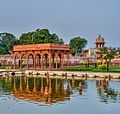Portal:Gardening
The Gardening Portal

Gardening is the process of growing plants for their vegetables, fruits, flowers, herbs, and appearances within a designated space. Gardens fulfill a wide assortment of purposes, notably the production of aesthetically pleasing areas, medicines, cosmetics, dyes, foods, poisons, wildlife habitats, and saleable goods (see market gardening). People often partake in gardening for its therapeutic, health, educational, cultural, philosophical, environmental, and religious benefits. Gardening varies in scale from the 800 hectare Versailles gardens down to container gardens grown inside. Gardens take many forms, some only contain one type of plant while others involve a complex assortment of plants with no particular order. (Full article...)
Horticulture is the science, technology, art, and business of cultivating and using plants to improve human life. Horticulturists and Horticultural Scientists create global solutions for safe, sustainable, nutritious food and healthy, restorative, and beautiful environments. This definition is seen in its etymology, which is derived from the Latin words hortus, which means "garden" and cultura which means "to cultivate". There are various divisions of horticulture because plants are grown for a variety of purposes. These divisions include, but are not limited to: gardening, plant production/propagation, arboriculture, landscaping, floriculture and turf maintenance. For each of these, there are various professions, aspects, tools used and associated challenges; Each requiring highly specialized skills and knowledge of the horticulturist. (Full article...)
General images -
Selected article -

The early history of gardening is largely entangled with the history of agriculture, with gardens that were mainly ornamental generally the preserve of the elite until quite recent times. Smaller gardens generally had being a kitchen garden as their first priority, as is still often the case.
The broad traditions that have dominated gardening since ancient times include those of the Ancient Near East, which became the Islamic garden, the Mediterranean, which produced the Roman garden, hugely influencing later European gardening, and the Chinese garden and its development on the Japanese garden. While the basic gardening techniques were fairly well understood by trial and error from early on, the plants available in a particular location have changed enormously, especially in recent centuries. Many new groups of plants have been introduced from other parts of the world, and the ornamental plants now used are mostly cultivars bred to improve qualities such as colour, length of flowering, size and hardiness. (Full article...)Selected image

Related portals
Did you know -
- ... that the New Zealand Geographic Board initially rejected the name of the Garden of Eden Ice Plateau for being biblical in origin?
- ... that popular garden plants like malfurada often escape from cultivation and become invasive?
- ... that Mel Bartholomew, who developed the time-saving square foot gardening method, said that he gardened "with a salad bowl in mind, not a wheelbarrow"?
- ... that actress Katharine Hepburn threatened to remove her name from a garden in Dag Hammarskjöld Plaza when New York City officials said they would not widen the plaza?
- ... that the Berggarten, a historic botanical garden since 1750 in Herrenhausen, features a mausoleum, where members of the royal family were interred?
- ... that Nusrati attributes the virtues of a good ruler to his patron Ali Adil Shah II in The Rose Garden of Love?
- ... that a cactus is named after Gertrude Webster, who helped found the Desert Botanical Garden in Arizona?
- ... that the Cranford Rose Garden at Brooklyn Botanic Garden was cited as having 1,200 varieties of roses?
Things you can do
- This list is transcluded from the tasks list page. To edit the list, click here
 |
Here are some tasks awaiting attention:
|
WikiProjects
Topics
Categories
Associated Wikimedia
The following Wikimedia Foundation sister projects provide more on this subject:
-
Commons
Free media repository -
Wikibooks
Free textbooks and manuals -
Wikidata
Free knowledge base -
Wikinews
Free-content news -
Wikiquote
Collection of quotations -
Wikisource
Free-content library -
Wikiversity
Free learning tools -
Wiktionary
Dictionary and thesaurus






















































































